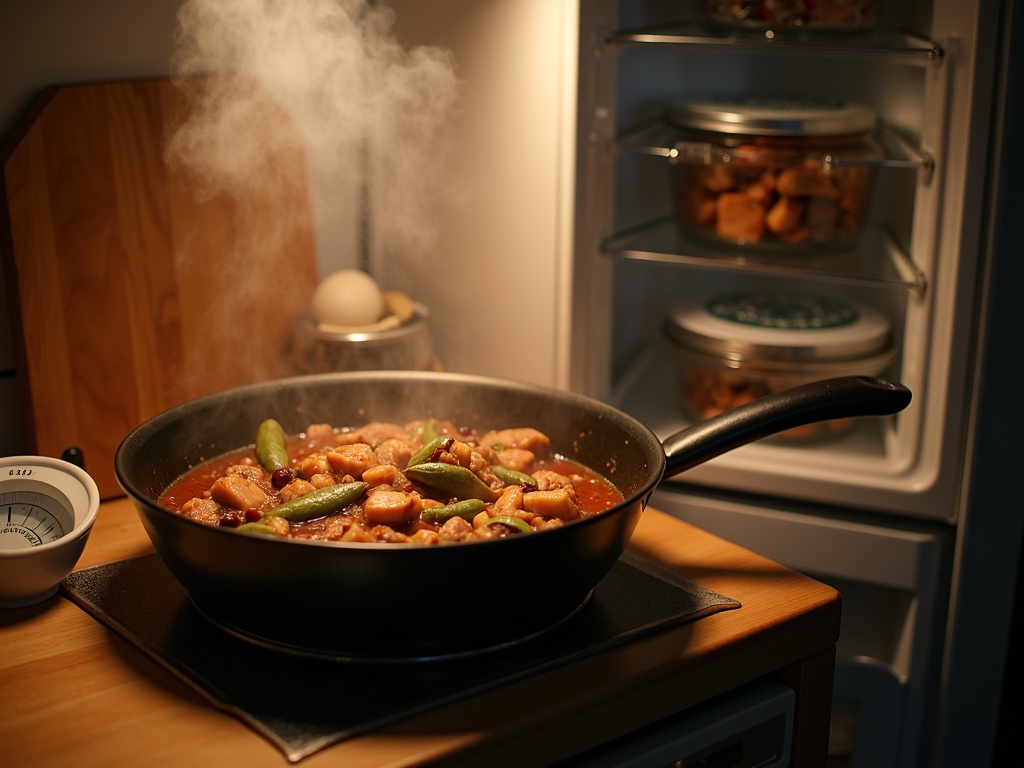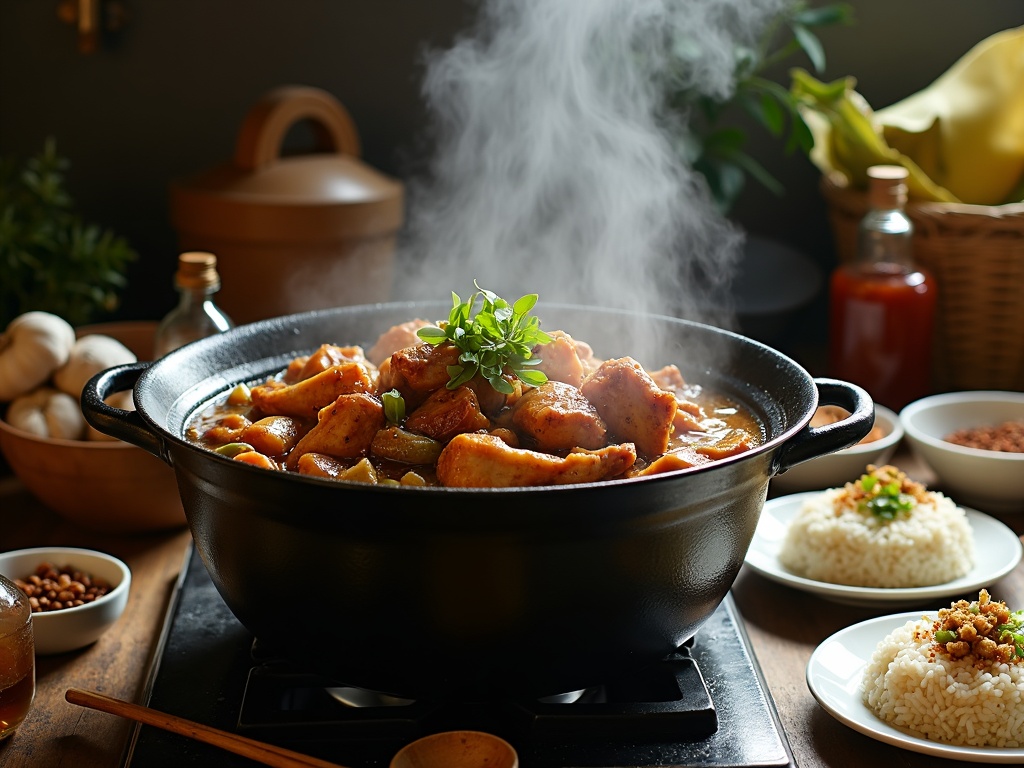Adobo: The Unofficial National Dish of the Philippines
Adobo recipe, the unofficial national dish of the Philippines, blends vinegar, soy sauce, garlic, bay leaves, and peppercorns to turn simple meat into a complex culinary masterpiece.
This iconic dish represents Filipino cultural identity while offering practical preservation benefits, with each family cherishing their unique version passed down through generations.
Table of Contents
Key Takeaways
- The perfect balance of sour, salty, and savory flavors comes from equal parts vinegar and soy sauce, creating adobo’s signature taste profile.
- Traditional adobo uses bone-in chicken thighs or fatty pork cuts which remain juicy while absorbing the rich marinade during cooking.
- Allowing meat to marinate overnight and browning it before simmering creates deeper, more complex flavors in the final dish.
- Adobo improves with time, making leftovers sometimes more flavorful than the freshly prepared dish.
- Steamed white rice is the quintessential partner for adobo, helping to soak up the savory sauce and complete the authentic Filipino eating experience.
What Makes Adobo So Special
Adobo holds a treasured place in Filipino cuisine as the unofficial national dish, capturing the essence of the country’s culinary history in a single pot. This dish exemplifies how simple ingredients can create complex flavors when prepared with love and attention to detail. Beyond just being delicious, adobo represents Filipino identity and has become a source of pride that connects generations through shared meals.
Cultural Cornerstone of Filipino Identity
As the national dish of the Philippines, adobo carries significant cultural weight. Every Filipino family has their own unique version, with slight variations passed down through generations. These family recipes tell stories of ancestry, migration, and adaptation. The dish predates Spanish colonization, though its name comes from the Spanish word “adobar” (to marinate). This history reflects the Philippines’ complex cultural influences while remaining distinctly Filipino at heart.
The cooking method itself is practical – combining vinegar, soy sauce, and spices creates both incredible flavor and acts as a natural preservative. This preservation technique was especially valuable before refrigeration existed. I’ve found that the cooking techniques used in adobo share similarities with other cultures that developed methods to keep food fresh in tropical climates.
What’s fascinating is how adobo has become a unifying cultural touchstone. While regional variations exist throughout the 7,000+ islands of the Philippines, the fundamental elements remain consistent – creating a culinary common ground that all Filipinos recognize as their own.
A Perfect Balance of Flavors
The magic of adobo lies in its simple but perfect balance of ingredients creating rich umami depth. The foundational components include:
- Vinegar: Provides tang and acts as a preservative
- Soy sauce: Delivers saltiness and dark color
- Garlic: Offers aromatic pungency
- Bay leaves: Add subtle herbal notes
- Black peppercorns: Bring gentle heat
- Meat (typically chicken or pork): Becomes tender as it absorbs the sauce
This combination creates a harmonious taste experience that’s simultaneously sour, salty, savory, and slightly sweet. The long, slow cooking process allows the meat to become incredibly tender while absorbing all these flavors. What starts as simple ingredients transforms into a comforting dish with complex flavor notes that change and develop with each bite.
I appreciate how adobo exemplifies the beauty of patience in cooking. The dish actually improves with time – many Filipinos insist adobo tastes better the day after cooking, as the flavors continue to meld and deepen. This quality makes it perfect for batch cooking and enjoying throughout the week.
The versatility of adobo is another remarkable aspect. While chicken and pork are traditional proteins, you can adapt the technique for whatever you have available:
- Vegetables like kangkong (water spinach)
- Seafood options such as squid or shrimp
Each variation maintains the essential adobo character while offering new flavor dimensions.
The cooking process itself creates a sauce with incredible depth that’s perfect for spooning over a mound of steaming white rice. The contrast between the savory, tangy sauce and the neutral canvas of rice creates the ultimate comfort food experience — satisfying in a way that transcends cultural boundaries.
This balance of accessibility and complexity makes adobo special. It’s straightforward enough for beginners to tackle successfully but contains enough nuance for experienced cooks to continually refine their approach. The dish demonstrates how the most satisfying food often comes from simple ingredients transformed through thoughtful technique rather than exotic components.
Essential Ingredients for Perfect Adobo
Adobo has earned its reputation as the national dish of the Philippines for good reason. The secret to an authentic adobo lies in using the right ingredients that create its signature tangy, savory flavor. I’ve found that quality ingredients make all the difference when preparing this classic dish.
Primary Adobo Components
The foundation of any great adobo starts with choosing the right protein. Pork belly offers rich, fatty goodness that becomes tender after braising, while chicken thighs remain juicy and absorb the sauce beautifully. For the most flavorful results, I prefer using bone-in chicken thighs or pork belly with the skin intact.
Filipino soy sauce differs slightly from Chinese or Japanese varieties, offering a distinct flavor profile that’s crucial for authentic adobo. It’s slightly saltier with unique fermented notes that form the base of the dish’s savory character.
The acidic component comes from white or cane vinegar, which tenderizes the meat while creating that signature tangy taste. The ratio of vinegar to soy sauce is critical—I typically use equal parts for a balanced flavor, though you can adjust according to your preference for more tanginess.
Whole garlic cloves are essential, not just minced or chopped. When simmered slowly, they mellow and infuse the sauce with aromatic depth. I recommend using at least an entire head of garlic, crushed slightly to release their flavors.
Supporting Aromatics and Seasonings
Whole black peppercorns add subtle heat and complexity to traditional chicken dishes like adobo. Unlike ground pepper, whole peppercorns slowly release their flavor during the cooking process.
Bay leaves contribute an herbal undertone that ties all the flavors together. Traditional Filipino cooking usually calls for dried bay leaves, but fresh ones work wonderfully too if you can find them.
Salt should be added sparingly and only after tasting, as the soy sauce already provides significant saltiness. For best results, I recommend using a high-quality cooking oil with a high smoke point like vegetable or canola oil when initially browning the meat.
These ingredients work together through a slow simmering process, creating that delicious sauce that’s perfect for pouring over steamed rice. The beauty of adobo lies in its simplicity—these few ingredients create a complex, crave-worthy dish that improves with time as the flavors meld together.
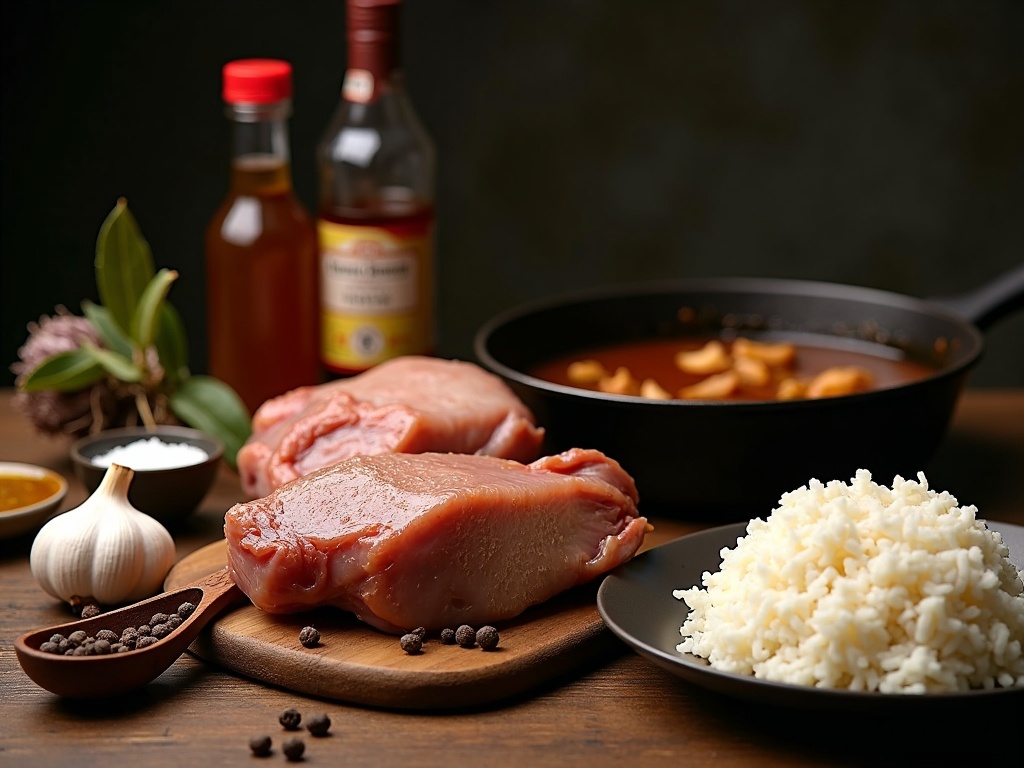
How to Cook Traditional Adobo
Adobo stands as one of the most iconic dishes in Filipino cuisine, known for its perfect balance of savory, tangy, and slightly sweet flavors. Making authentic adobo at home is straightforward once you understand the key steps. I’ve cooked this dish countless times, and the rich, complex flavors never fail to impress guests.
Preparing the Marinade and Meat
The foundation of any great adobo lies in its marinade. I start by combining equal parts soy sauce and vinegar in a large bowl. This ratio creates the signature tangy-salty base that adobo is famous for. To this mixture, I add crushed garlic cloves, whole peppercorns, and a bay leaf or two for depth of flavor.
For the meat, traditional choices include chicken, pork, or a combination of both. The meat should marinate for at least 30 minutes, though I’ve found that overnight marination in the refrigerator produces the most flavorful results. This extended marinating time allows the meat to fully absorb the complex flavors of the sauce.
When you’re ready to cook, remove the meat from the marinade but don’t discard the liquid—it forms the base of your sauce. Pat the meat pieces dry with paper towels to ensure proper browning in the next step.
Cooking Process and Final Touches
Heat a heavy-bottomed pan or Dutch oven over medium-high heat. Add a small amount of oil and brown the marinated meat on all sides until it develops a beautiful golden crust. This crucial step locks in flavor and creates texture contrast in the finished dish.
Once the meat is browned, pour in the reserved marinade along with:
- Additional bay leaves for aroma
- More whole peppercorns
- A splash of water if needed
- Optional additions like a pinch of sugar to balance acidity
Bring the mixture to a boil, then reduce to a simmer. Cover and cook until the meat becomes fork-tender—typically about 30–45 minutes for chicken and up to an hour for pork. The meat should remain intact but fall apart easily when pressed with a fork.
During the final 10–15 minutes of cooking, remove the lid to allow the sauce to reduce and thicken naturally. The goal is a glossy, concentrated sauce that clings to the meat. Some butter chicken recipes use a similar reduction technique, though adobo’s flavor profile is completely different.
For an authentic presentation, serve your adobo hot over freshly steamed rice, which absorbs the rich sauce beautifully. I like to garnish with sliced green onions for a fresh contrast to the savory dish. Many Mexican dishes feature similar acid-cooked proteins, but adobo’s distinct Asian flavor profile with soy and vinegar makes it unique.
For a complete meal, consider adding a side of sautéed vegetables or a fresh tomato salad similar to a pico de gallo recipe to balance the richness of the adobo. The acidity of tomatoes complements the savory depth of the dish perfectly.
The beauty of adobo lies in its simplicity and flexibility. Once you’ve mastered the basic technique, you can experiment with variations like:
- Adding coconut milk for a creamier sauce
- Incorporating vegetables such as potatoes
The principles of making paella and other one-pot dishes apply here too—let the ingredients meld together slowly for the best flavor development.
Remember that authentic adobo tastes even better the next day, as the flavors continue to develop and intensify overnight. This makes it an excellent make-ahead dish for busy weeknights or special gatherings.
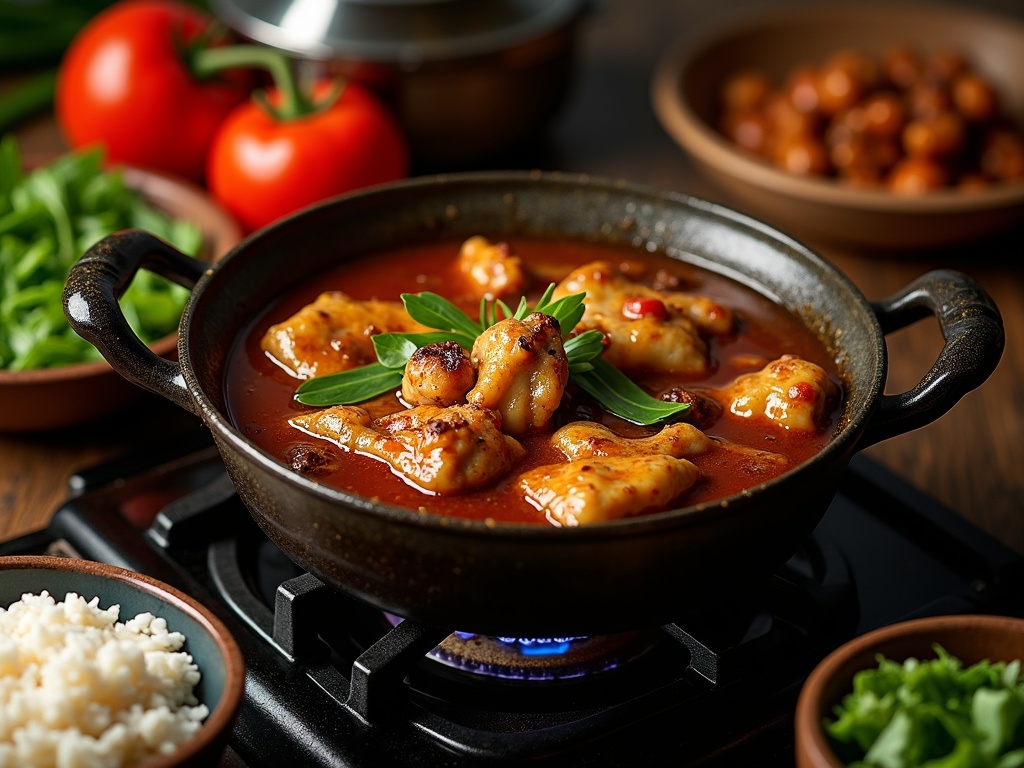
Common Mistakes to Watch Out For
Creating the perfect adobo dish requires attention to a few key details. I’ve noticed several common errors that can turn this beloved Filipino dish from extraordinary to ordinary. Let’s dive into these pitfalls so you can avoid them in your cooking journey.
Recipe Execution Errors
Using the wrong vinegar-to-soy sauce ratio can dramatically affect your adobo’s flavor profile. The ideal proportion typically hovers around 1:1, but this can vary depending on personal taste. Too much vinegar creates an overwhelmingly sour dish, while excessive soy sauce results in a saltiness that overpowers the other flavors. When experimenting with different vinegar varieties in your recipe, always start with the standard ratio and adjust gradually.
Cooking on high heat is a shortcut that leads to disappointment. Adobo benefits from a slow, gentle simmer that allows the meat to become tender while absorbing the rich marinade. High heat can cause the sauce to reduce too quickly, leaving you with tough meat and an overly concentrated sauce.
Many cooks skip the browning step in their rush to finish cooking. This crucial stage develops deep flavor compounds through the Maillard reaction. Before simmering, take time to brown your meat pieces on all sides. This simple step creates a foundation for a complex, rich flavor profile that distinguishes great adobo from good adobo.
Using lean meat cuts might seem healthier, but adobo traditionally calls for fattier pieces.
- Chicken thighs work better than breasts
- Pork belly or shoulder outperforms loin
The fat renders during cooking, adding richness to the sauce and keeping the meat moist throughout the long cooking process.
Adding water too early dilutes the marinade before it has a chance to penetrate the meat. Allow the meat to marinate in the vinegar-soy mixture without water for maximum flavor absorption. Water should only be added during the simmering phase if needed to achieve your desired sauce consistency. This technique creates a more authentic flavor experience similar to traditional recipes.
By avoiding these common mistakes, your adobo will develop that characteristic tangy-savory flavor that makes this dish a favorite across dinner tables globally.

Pro Tips for the Best Results
Creating the perfect adobo isn’t just about following a recipe—it’s about understanding the little techniques that elevate this classic dish from good to unforgettable. After years of perfecting my adobo technique, I’ve gathered several key insights that make all the difference in the final result.
Secret Techniques for Adobo Excellence
- Marinate Overnight: Allowing your meat to marinate overnight creates a depth of flavor that simply can’t be achieved with a quick soak. The vinegar and soy sauce need time to penetrate the meat fibers, creating that distinctive tangy-savory profile that great flavor combinations are known for. I place my marinating meat in a glass container rather than metal to prevent any unwanted reactions with the acidic marinade.
- Choose the Right Cut of Meat: When selecting meat cuts, don’t shy away from fattier options—they’re your friend in adobo. Chicken thighs work much better than breasts, while pork belly or shoulder creates a more tender, flavorful result than leaner cuts. The fat renders down during cooking, adding richness to your sauce and keeping the meat juicy, similar to how fat adds character in traditional butter chicken preparations.
- Perfect Sauce-to-Meat Ratio: The balance between sauce and meat is crucial for authentic adobo. You want enough liquid to create a flavorful braise without drowning the meat. My rule of thumb: the liquid should cover about two-thirds of your meat in the pot. This creates the perfect reduction as it simmers, resulting in that glossy, intensely flavored sauce that’s characteristic of proper international dishes with reduced sauces.
- Let the Dish Rest: Patience makes perfect when it comes to serving adobo. I always let the meat rest for 10–15 minutes after cooking. This allows the juices to redistribute throughout the meat instead of spilling out when cut, keeping each bite moist and flavorful. This resting period also gives the sauce time to thicken slightly and cool to an ideal serving temperature.
- Make the Most of Leftovers: One of adobo’s greatest qualities is how it improves with age. The flavors meld and deepen overnight, making leftovers sometimes even better than the first serving. Store your leftover adobo in its sauce in the refrigerator, and you’ll find the next day’s meal has developed a more complex flavor profile. This quality makes adobo perfect for meal prep, similar to how paella flavors intensify over time.
- Use Whole Peppercorns: For an extra layer of flavor, try toasting your peppercorns and crushing them fresh rather than using pre-ground pepper. The aromatic oils released create a more pronounced peppery note that cuts through the richness of the dish beautifully.
- Minimize Stirring: When simmering your adobo, avoid frequent stirring. Let the meat cook undisturbed for the most part, only gently turning occasionally. This prevents the meat from breaking apart while still allowing it to absorb the flavors of the sauce.
- Thicken the Sauce Separately: For a thicker, more concentrated sauce, you can remove the cooked meat once tender and continue reducing the liquid. Then simply return the meat to the thickened sauce before serving. This technique creates a more intensely flavored coating for the meat without overcooking it.
- Serve with Fresh Sides: Finally, serving adobo with fresh accompaniments like sliced tomatoes or a simple salad creates a pleasant contrast to the rich, savory flavors of the dish. The acidity and freshness cut through the umami-packed sauce for a perfectly balanced meal that showcases the authentic cultural heritage behind this beloved recipe.
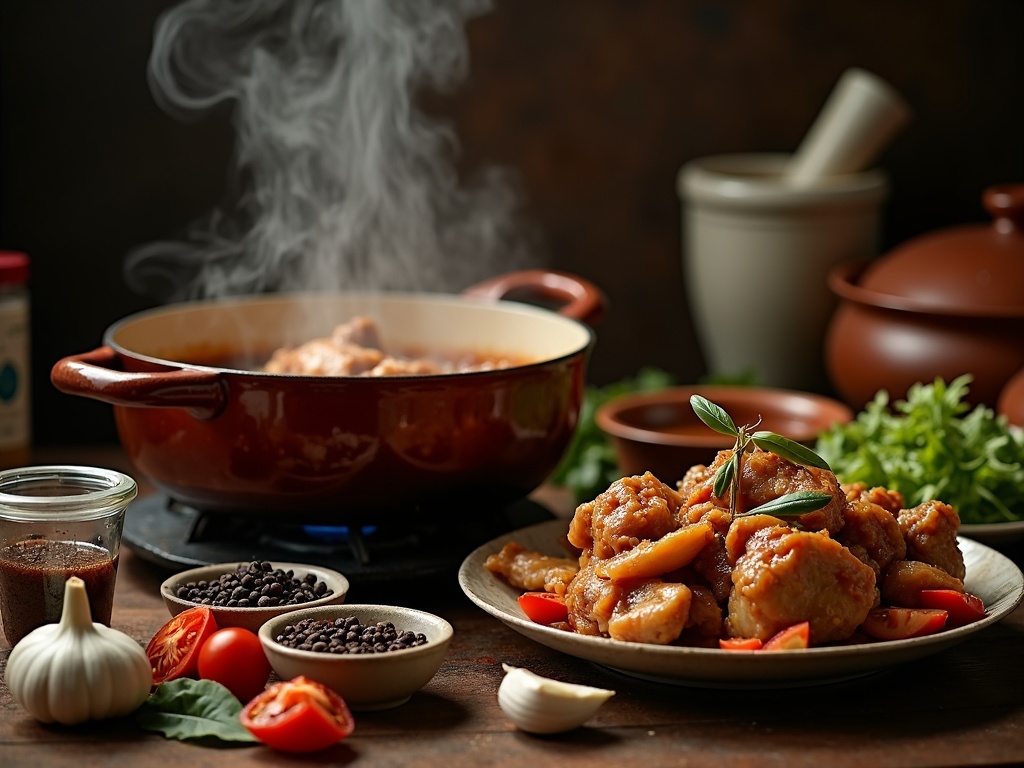
Serving Suggestions
Adobo’s rich, tangy sauce deserves to be paired with complementary sides that enhance its flavor profile. I’ve discovered that the right accompaniments can transform this Filipino classic from a simple meal to an unforgettable dining experience. The combination of savory, slightly sweet, and tangy elements in adobo calls for sides that balance these bold flavors.
Perfect Pairings for Your Adobo
Steamed white rice remains the quintessential partner for adobo. The plain, fluffy rice serves as an ideal canvas for soaking up the savory sauce. I find that using jasmine or long-grain varieties works best, as they maintain their structure while absorbing all those delicious flavors. For an elevated experience, I sometimes serve my adobo with rice that’s been cooked in chicken broth instead of water.
Garlic rice (sinangag) adds another dimension to your meal. This Filipino favorite features day-old rice stir-fried with lots of minced garlic. The toasty, aromatic qualities of garlic rice create a delightful contrast to adobo’s tanginess. To make it properly, I sauté minced garlic until golden before adding in the rice and a pinch of salt.
For a refreshing counterpoint to the rich adobo, green papaya achara is hard to beat. This traditional pickled side dish offers:
- A crunchy texture that contrasts with the tender meat
- Bright acidity that cuts through the richness
- A hint of sweetness that complements the savory elements
- Vibrant color that makes your plate visually appealing
I particularly enjoy making this tangy condiment a day ahead so the flavors have time to meld together.
Chopped green onions sprinkled over your adobo just before serving add a pop of color and a mild bite. I like to slice them on a diagonal for a more elegant presentation. The subtle onion flavor provides a nice contrast to the richness of the dish without overpowering it.
Fried garlic bits offer a wonderful textural element and intensify the garlic notes already present in traditional adobo. I make these by slowly frying thinly sliced garlic in oil until golden and crispy, then draining well on paper towels. These crunchy morsels can be sprinkled over your dish just before serving for maximum impact.
For a complete Filipino feast, consider adding other traditional sides like ensaladang talong (eggplant salad) or pinakbet (vegetable stew). These vegetable-forward dishes help balance the meat-centric nature of adobo and round out the meal.
Don’t forget about beverage pairings! A cold San Miguel beer or calamansi juice makes for an authentic Filipino dining experience. For something non-alcoholic, I find that fresh coconut water complements the flavors beautifully while providing a cooling effect.
For a more substantial meal, fried plantains (maruya) offer a sweet contrast to adobo’s savory profile. Their caramelized exterior and soft interior make them an excellent side that can double as dessert.
When hosting guests, I like to create a spread of these accompaniments and let everyone customize their plate. This interactive approach makes for a memorable dining experience and introduces people to the varied textures and flavors of Filipino cuisine.
For leftover adobo, try serving it with freshly baked crusty bread instead of rice the next day. The bread is perfect for sopping up the intensified flavors that develop overnight.
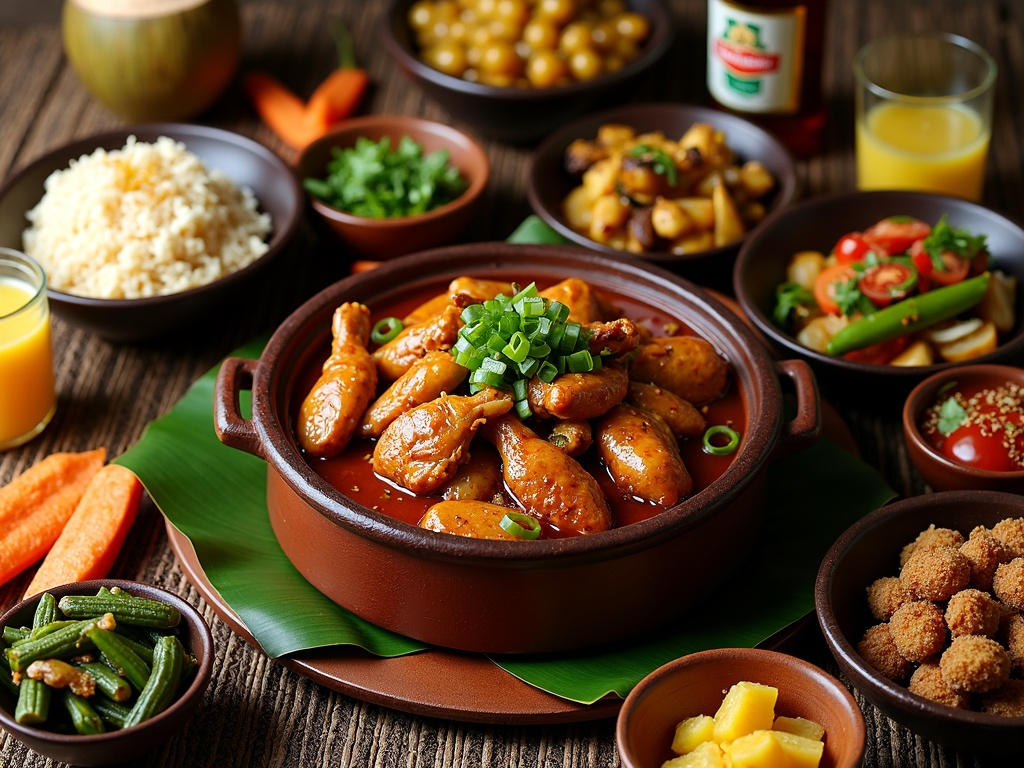
Storage and Reheating Guide
After cooking a delicious batch of adobo, you’ll want to know how to preserve its rich flavors for later enjoyment. Proper storage and reheating techniques ensure your adobo maintains its distinctive taste and texture even days after preparation.
Proper Storage Techniques
Adobo actually tastes better the next day when the flavors have had time to deepen and meld together. For short-term storage, place your cooled adobo in an airtight container and keep it refrigerated for up to 4 days. The vinegar in adobo acts as a natural preservative, which helps maintain its quality in the refrigerator.
For longer preservation, adobo freezes exceptionally well. To freeze:
- Allow the adobo to cool completely
- Transfer to freezer-safe containers or heavy-duty freezer bags
- Label with the date and contents
- Store in the freezer for up to 3 months
When properly sealed, frozen adobo maintains its flavor profile remarkably well, making it perfect for quick and satisfying meals when you’re short on time.
Reheating for Optimal Flavor
The key to reheating adobo is patience. Slow reheating preserves the dish’s complex flavors and keeps the meat tender. The stovetop method works best, allowing you to monitor the consistency and temperature.
To reheat your adobo properly:
- Transfer the desired portion to a heavy-bottomed pan
- Heat over medium-low heat, stirring occasionally
- Add a splash of water if the sauce has thickened too much during storage
- Heat until the internal temperature reaches 165°F (74°C)
This gentle reheating approach prevents the meat from becoming tough or dry while revitalizing all the aromatic elements of the dish. The additional water helps restore the sauce to its original consistency, ensuring each bite remains as flavorful as when first prepared.
For frozen adobo, it is best to thaw it overnight in the refrigerator before reheating. This gradual transition helps maintain the integrity of both the meat and sauce. If you’re in a hurry, you can use your microwave’s defrost function, but the stovetop method delivers the most consistent results for the final reheating.
